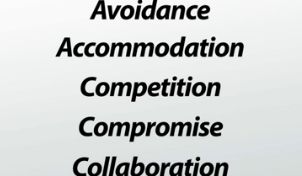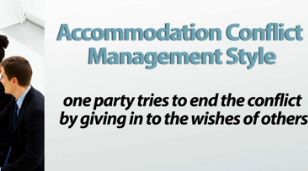Conflict Resolution: Managing Conflict in Organizations - Quiz
Choose your answer and write the correct one down. Then click HERE for the answers to this quiz.
NOTE: The transcript from the video is listed below the quiz for your reference.
1. Which of these conflict management styles attempts to ignore the disagreement?
- avoidance
- accommodation
- collaboration
- compromise
- competition
2. Which of these conflict management styles involves one party trying to end the conflict by giving in to the wishes of others?
- avoidance
- accommodation
- collaboration
- compromise
- competition
3. Which of these conflict management styles occurs when the objective is to win and to make the other lose, no matter the expense?
- avoidance
- accommodation
- collaboration
- compromise
- competition
4. Which of these conflict management styles attempts to resolve a conflict by finding a middle ground?
- avoidance
- accommodation
- collaboration
- compromise
- competition
5. Which of these conflict management styles works to find a solution that both parties are satisfied with without feeling a sense of sacrifice?
- avoidance
- accommodation
- collaboration
- compromise
- competition
Conflict can be solved in many ways. This lesson provides an overview of the different types of conflict resolution strategies, including avoidance, accommodation, competition, compromise, and collaboration.
The Conflict
Rub-A-Dub Soap Company is getting ready to launch their new organic product line of soaps: O-Natural. The marketing department has been tasked with developing a promotional campaign that will advertise the new product line and promote sales of the O-Natural products. The director of marketing has assigned two of his best marketing representatives to work on this project: Eddie and Chase.
 |
Unfortunately, Eddie and Chase do not agree on the best way to promote the new product line. Eddie believes that a direct mail campaign to existing Rub-A-Dub customers would be the best way to reach the target audience. Chase thinks that Eddie's idea will limit them from reaching new clients as well as old ones and rather than doing a direct mail campaign, they should create a dynamic infomercial to show the world what O-Natural can really do. Eddie thinks that an infomercial is a waste of money and worries about the logistics of putting it together.
The more they debate on the issue, the more they disagree. Eddie and Chase decide to present both ideas to the director but are told that they need to make the decision themselves. How will Eddie and Chase resolve their disagreement on how to best promote the new product line? Luckily for Eddie and Chase, there are several different ways to manage conflict, including avoidance, accommodation, competition, compromise, and collaboration. To better understand each of these styles, we can apply them to our conflict situation between Eddie and Chase.
Avoidance
A common way of dealing with conflict, especially for those who do not like it, is to avoid it. If the parties in our conflict scenario choose the avoidance conflict management style, they will simply attempt to ignore the disagreement. Perhaps Chase does not like the hassle of dealing with the challenge and difficulty of negotiation. Eddie might be unassertive and afraid to hurt Chase's feelings by not accepting his idea as the best one. Unfortunately for Eddie and Chase, they must make a decision on which idea to use for the promotional campaign, making the avoidance conflict management style ineffective in this scenario.
 |
Avoiding conflict can signal to the other party that you simply do not care enough about them to work through the issue. It can also allow for emotions to fester, making conflict worse. Of course, there are times where people need to cool off and take some time to think about the issue more, making it advantageous to temporarily use an avoidance conflict management style.
Accommodation
Another option for solving this conflict would be for Chase and Eddie to use an accommodation conflict management style, whereby one party tries to end the conflict by giving in to the wishes of others. Eddie could decide to accommodate Chase because he has little interest in which promotional campaign they eventually implement. Perhaps Eddie is new to the marketing department and does not want to appear like he is not a team player in Chase's eyes.
Those with a high need for approval tend to accommodate more. Beyond seeking approval, it also says to the other party that you are a reasonable person and willing to bend on your position. Perhaps you realize that you are wrong, and rather than clinging on stubbornly to your position, you show humility and admit your faults.
 |
Accommodation also has its disadvantages. Giving in too early can lead to bad decision making because the issues go, for the most part, unexamined. Many conflicts require time to discuss several possible solutions before choosing which one best solves the issue - accommodating is often done with little to no discussion of all potential solutions.
Competition
One conflict management style that can be especially damaging is competition, which occurs when the objective is to win and to make the other lose, no matter the expense. If Eddie or Chase has little concern for the other party, they may compete. Competition is mostly about power or the ability to influence the other party to accept their point of view as the best position.
While both parties in this scenario are looking to see their idea implemented, only one of them can walk away satisfied if a competition style is used. Competition can create a hostile and defensive environment, making it difficult to reach an agreement. This could also negatively affect Eddie and Chase's working relationship going forward.
Compromise
Because Eddie and Chase both care about the end result of this conflict, a compromise may be needed. A compromise conflict management style attempts to resolve a conflict by finding a middle ground. The compromise is considered a lose-lose strategy because for each party to get something they want, they have to sacrifice something that they would prefer not to give up. Compromise is about a give-and-take where you win and lose simultaneously.
 |
For the parties in our scenario, a compromise would involve Eddie and Chase meeting half-way on which promotional campaign to choose - possibly splitting the total funds allotted for the campaign so that both a direct mail and infomercial can be used but on a smaller scale. A compromise might be the fastest way to solve this conflict so that Eddie and Chase can continue their working relationship in a cooperative and supportive manner. However, if splitting the funds will not be enough to support both campaigns, a compromise will be unlikely.
Collaboration
Collaboration is the win-win conflict management style where each party has a genuine concern for both themselves and others. To compromise is to win and to lose something, whereas to collaborate is to take the time to find a solution with which both parties are comfortable. Power, supremacy, and winning are not as important when collaborating as finding a solution that both parties are satisfied with without feeling a sense of sacrifice.
When using a collaborative conflict management style, personal grievances must be left behind so that the problems can be addressed without passing judgment or evaluating the individual. Both parties must be open to the opinions and ideas of the other side and willing to put forth the effort needed to truly collaborate. Naturally, effort and time commitment are significant when collaborating, which is the main disadvantage of collaborating to solve conflict. Collaboration requires a good deal of patience, which is something that is difficult to find in time-sensitive situations.
If Eddie and Chase were to use a collaborative conflict management style, they may need to scratch their individual ideas of using either a direct mail or infomercial and work on an entirely new way to promote the new product line together. While this would be time consuming, it would allow for both Eddie and Chase to develop a campaign idea that they are both satisfied with.
 |
Lesson Summary
Let's review. When trying to solve conflict, there are several conflict management styles to choose from, including avoidance, accommodation, competition, compromise, and collaboration.
- The avoidance conflict management style attempts to ignore the disagreement altogether but is useful when people need time to cool off and think about the issue.
- The accommodation conflict management style is used when one party tries to end the conflict by giving in to the wishes of others. Accommodation is typically used by people who seek the approval of others or when the conflict is of little importance to the person accommodating.
- The competition conflict management style occurs when the objective is to win and to make the other lose, no matter the expense. Competition is mostly about power or the ability to influence the other party to accept their point of view as the best position.
- The compromise conflict management style attempts to resolve a conflict by finding a middle ground. The compromise is considered a lose-lose strategy because for each party to get something that they want, they have to sacrifice something that they would prefer not to give up.
- The collaborative conflict management style is the win-win conflict management style that works to find a solution that both parties are satisfied with without feeling a sense of sacrifice.